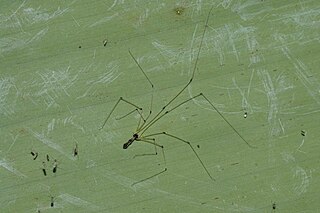Pacullidae is a family of araneomorph spiders first described by Eugène Simon in 1894. It was merged into Tetrablemmidae in 1958, then raised back to family status after a large phylogenetic study in 2017.

Pholcus is a genus of spiders of long-bodied cellar spider and allies in the family Pholcidae, with 375 described species as of January 2023.

Uthina is a genus of cellar spiders that was first described by Eugène Louis Simon in 1893.
Psechrus is a genus of cribellate araneomorph spiders in the family Psechridae, and was first described by Tamerlan Thorell in 1878.

Belisana is a genus of cellar spiders that was first described by Tamerlan Thorell in 1898.
Cantikus v-notatus is a species of spider in the family Pholcidae. It is found from Myanmar to Indonesia.
Calapnita is a genus of Southeast Asian cellar spiders that was first described by Eugène Louis Simon in 1892.
Nasoona is a genus of dwarf spiders that was first described by G. H. Locket in 1982.
Tissahamia is a genus of southeast Asian cellar spiders named after Wanniyalaeto chief Uru Warige Tissahami. It was erected in 20180 for several species transferred from Pholcus after a molecular phylogenetic study of the Calapnita-Panjange clade of Pholcidae. They have long, thin abdomens that bend upward near the end. They also have six eyes, three on each of two eye stalks.
Apokayana is a genus of southeast Asian cellar spiders named after the Apo Kayan people of Indonesia and Malaysia. It was erected in 2018 for ten species transferred from Panjange after a molecular phylogenetic study of Pholcidae.

Kintaqa is a genus of southeast Asian cellar spiders erected in 2018 for five species moved from Pholcus after a molecular phylogenetic study. They are medium-sized spiders, distinguished by their unique enlarged shape of fourth segment of pedipalps.
Meraha is a genus of southeast Asian cellar spiders. The genus was erected in 2018 for two species transferred from Pholcus after a molecular phylogenetic study of Pholcidae. The name is derived from the Malay "merah", meaning "red", referring to the reddish-orange hue of pedipalps. They are average sized cellar spiders with a cylindrical abdomen, and they build domed webs .5 to 2 metres above the ground.
Nipisa is a genus of southeast Asian cellar spiders erected in 2018 after a molecular phylogenetic study of Pholcidae. It consists of ten Calapnita species, previously the phyllicola group of Pholcidae, now elevated to genus rank. They are pale whitish in color, with a cylindrical abdomen and relatively long legs. The name is derived from the Malay "nipis", meaning "thin", in reference to the long, thin abdomen.
Pribumia is a genus of southeast Asian cellar spiders erected in 2018 for several species transferred from Pholcus after a molecular phylogenetic study of the Calapnita-Panjange clade of Pholcidae. Six species previously in the minang group of Pholcus were transferred, but P. tahai is now in Apokayana. They have long, thin abdomens and six eyes, three on each of two eye stalks. The name is derived from the local term for Native Indonesians.
Teranga is a genus of southeast Asian cellar spiders erected in 2018 for four species transferred from Pholcus after a molecular phylogenetic study of the Calapnita-Panjange clade of Pholcidae. They are medium-sized cellar spiders, averaging 3.5 to 4.5 millimetres in length, with longer legs, the first pair reaching 30 to 40 millimetres long. The abdomen is long and thin, with a slight upward bend near the end. The name is derived from the Malay "terang", meaning "bright", referring to their light color.
Bowie is a genus of Ctenidae that was described by Peter Jäger in 2022. The genus was named after the English singer-songwriter and actor David Bowie and currently encompasses 107 species, 55 of which were named after elements from David Bowie's musical catalogue.



